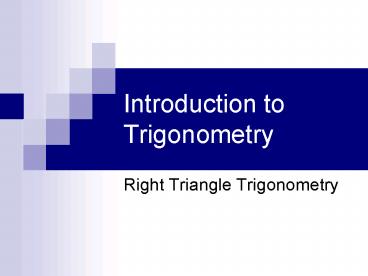Introduction to Trigonometry - PowerPoint PPT Presentation
1 / 32
Title:
Introduction to Trigonometry
Description:
Introduction to Trigonometry Right Triangle Trigonometry Computing Trigonometric Ratios This follows the PowerPoint titled: Labeling Right Triangles See if you can ... – PowerPoint PPT presentation
Number of Views:538
Avg rating:3.0/5.0
Title: Introduction to Trigonometry
1
Introduction to Trigonometry
- Right Triangle Trigonometry
2
Topic 2
This follows the PowerPoint titled Labeling
Right Triangles
Computing Trigonometric Ratios
See if you can find the link between this
presentation and AA
3
Trig Ratios
- Trigonometry is all about comparing the lengths
of two sides of a triangle. - When you compare two numbers, that is a ratio.
4
Trig Ratios
- Given this triangle, you can make a ratio of the
opposite side and the hypotenuse. (Angle x is
the reference angle.)
5
Trig Ratios
- The ratio of opposite side to hypotenuse is 6/10
or 0.6. - Knowing the ratio of two specific sides can tell
you how big angle x is...
6
Trig Ratios
- In this case, an opposite/hypotenuse ratio of 0.6
means that the ref. angle is 36.9 degrees. - Dont worry how you get that answer yet!
i.e. You would not have that ratio if the angle
was different
7
Student Activity
- In order to participate with the activities
discussed in the next several slides you will
need a protractor and a ruler with a metric scale
(millimeters).
8
Trig Ratios
- To practice writing trig ratios, make a small
table like this
9
Trig Ratios
- On a blank piece of paper, make a 6 (or so) long
line. At the left end of this line, draw a 35
degree angle. Be as precise as possible!
35
10
Trig Ratios
- Now measure across 30 mm from the vertex, then
draw a line straight up. This will form a right
triangle.
35
30 mm
11
Trig Ratios
- Now measure the vertical line and the hypotenuse
in millimeters.
and the hypotenuse
Measure this length...
35
30 mm
12
Trig Ratios
- With these measurements, fill in the column under
the heading 1st Triangle. - Click to see how this is done
13
Trig Ratios
- The first box has been filled-in and computed for
you. Finish the two below it...
14
Trig Ratios
- Hopefully your answers are similar to these
15
Trig Ratios
- Now measure 50 mm from the vertex, and make a
vertical line. As before, measure the vertical
line and hypotenuse.
35
50 mm
16
Trig Ratios
- Then fill-in the column headed 2nd Triangle.
17
Trig Ratios
- Your answers should be close to these
18
Trig Ratios
- Lastly, measure any distance from the vertex.
Create a right triangle, and measure the vertical
line and the hypotenuse.
35
19
Trig Ratios
- Fill-in the column 3rd Triangle with your data
20
Trig Ratios
- Now compare your data.
- Due to measurement error, there might be a few
discrepancies when comparing one column to the
next, but not much. - Your ratios going across a given row should end
up being about the same.
21
Trig Ratios
22
Trig Ratios
- These ratios are unique to a certain angle.
- If you had created a 70 angle, and filled-in the
three columns as before, your ratios (such as
opp/hyp) would all be the same but the value
would be different. It would be unique to a 70
degree angle.
23
Student Activity
- Draw a 75 angle.
- Create any three right triangles you want from
it. (Just like you did with the 35 angle.) - Fill in a chart just like you did for the last
problem and compute the ratios.
24
More on trig ratios
- In a perfect world the results for your second
table, the 75 angle, should look like this
25
Trig Ratios
- So what do these results tell you?
- First, every angle has a unique result for each
of these ratios
26
Trig Ratios
- For example, here are the ratios for a 20 angle
20
0.342
0.940
0.364
27
Trig Ratios
- A different angle, say 40, will have different
ratios
20
40
0.342
0.643
Similar Triangles
0.940
0.766
0.364
0.839
28
Trig Ratios
The other thing to remember is that for a given
angle, the size of the triangle you are working
with is irrelevant to how the ratios turn out.
Similar Triangles
29
Trig Ratios
- To illustrate this, the angle below (20) is
drawn, then several right triangles are formed.
In each triangle the ratio of opp/hyp is the same
no matter the size of the triangle.
opp/hyp
.342
1.82/5.32
5.32
1.82
20
Similar Triangles
30
Trig Ratios
- To illustrate this, the angle below (20) is
drawn, then several right triangles are formed.
In each triangle the ratio of opp/hyp is the same
no matter the size of the triangle.
opp/hyp
.342
4.37/12.77
12.77
4.37
20
Similar Triangles
31
Trig Ratios
- To illustrate this, the angle below (20) is
drawn, then several right triangles are formed.
In each triangle the ratio of opp/hyp is the same
no matter the size of the triangle.
opp/hyp
.342
6.55/19.16
19.16
6.55
20
Similar Triangles
32
See if you can find the link between this
presentation and AA
All Right triangles with a given angle, say 47
degrees, are similar due to AA so the ratios
will all be the same































